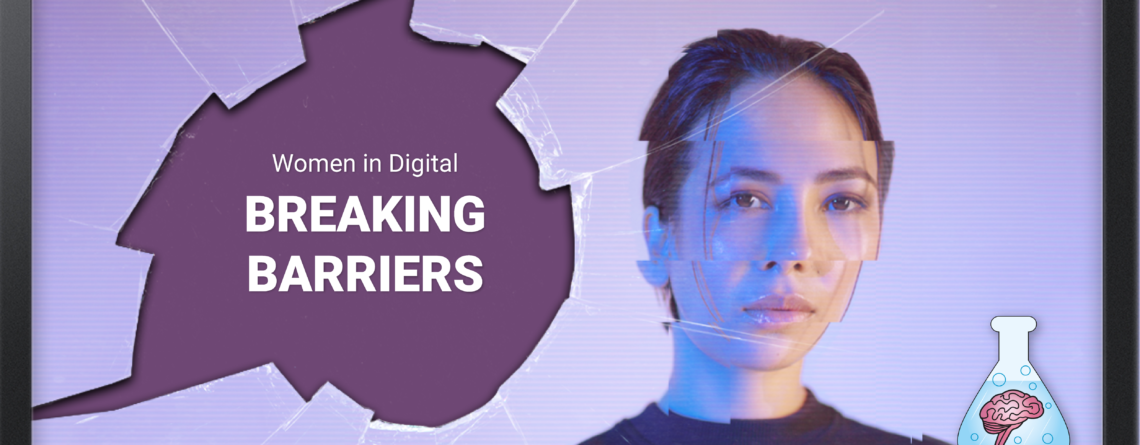Women in Digital: Breaking Barriers
Organisations cannot thrive if everyone thinks and behaves in the same way – diversity fuels innovation. But breaking down systematic sexism, especially in male-dominated industries such as tech, requires concerted and continuous effort. Studies have estimated that employing and promoting more women could boost some countries’ economy by an average of 35%. Even at Brainlabs, where we’ve always strived for a 50:50 gender ratio with inclusive hiring and progression policies, our tech department stands at only 31% female.
All of our fantastic female speakers today have strived to break the barriers they’ve encountered in the digital industry. But companies of all sizes have a responsibility to implement change and dismantle these barriers from within. Too often, the expectation is on individual women to smash the glass ceiling, but what can employers do?
Understand gender biases
To facilitate a gender-diverse workforce, comprehensive efforts must be made to break down the gender biases that have historically favoured men. Research has shown the following trends in workplace behaviour:
- Men attribute success to themselves and failure to others, while women do the opposite.
- Men tend to talk more in meetings, while women are interrupted more, given less credit for their ideas, and have less influence overall. Moreover, people expect help from women but not men, so women earn no extra points for doing favours at work.
- Men are more likely than women to ask for a pay rise, which often leads to males progressing at a faster rate than women.
So, how can you combat these issues in your business?
1. Representation starts at the top
To make gender inequality a thing of the past, businesses need to support women in leadership opportunities and foster a culture that encourages this. In 2019, women made up only 23.7% of Chief Executive and Senior Official positions (Catalyst, 2019). Female representation is vital for inclusivity, especially in male-dominated industries such as tech; without seeing females in power, young women won’t think leadership positions are available to them.
The first thing is set and track quantifiable goals. Set yourself a clear target of an equal gender split; conduct annual reviews of your senior management team to identify where more effort is required and pinpoint areas of success. Having a strong female presence within your leadership team ensures gender equality remains a priority at every level of the company.
2. Recruitment
Regardless of your industry, it’s imperative to create initiatives that consider the needs of as diverse a group possible. Recruitment processes often favour males in many ways, creating a gender imbalance from the very beginning of the employment chain. Job adverts often use gender biases which can discourage female applicants. Research suggests that women apply for positions when they’re confident of fulfilling all criteria, while men apply when they fulfil 60%. Men are also more likely to be hired based on potential, while women are hired on experience.
Once you’re aware of these common biases, you can put a number of initiatives in place to counteract these gender imbalances and attract more female talent.
By monitoring the wording in job adverts via semantic analysis, any gendered language can be identified and eliminated. In Brainlabs’ job descriptions, we keep specific requirements to a minimum and don’t list any necessary experience; we’ve found this to be a really effective way of attracting more female applicants.
3. Transparency in pay and promotion
Transparency in pay is incredibly important, and an effective way of building trust amongst your team; gender should not make a difference to how much your employees are paid. Placing every employee on a salary progression table is a great way of communicating pay transparently; this provides clarity for what is needed to progress to the next pay bracket and what increase can be expected. It also eliminates the need to ask for promotions.
We also have a ‘no-bonus’ policy, to avoid nurturing a competitive culture which can be unmotivating to women.
If you do notice discrepancies in your organisation, make active efforts to change: businesses should constantly be evolving. Three years ago, we analysed pay across our staff and found a gap of 8.6%, which was unacceptable. We published this value on our website, and created an action plan to increase women’s salaries by an average of that value there and then. Our efforts were featured in national press and radio. Since then, we have maintained a 0% median pay gap.
Equality is a journey rather than a destination. Efforts should be continued and constantly evolving, so if you think you’re doing enough as a company, it’s time to come up with some new initiatives by seeking fresh ideas.




